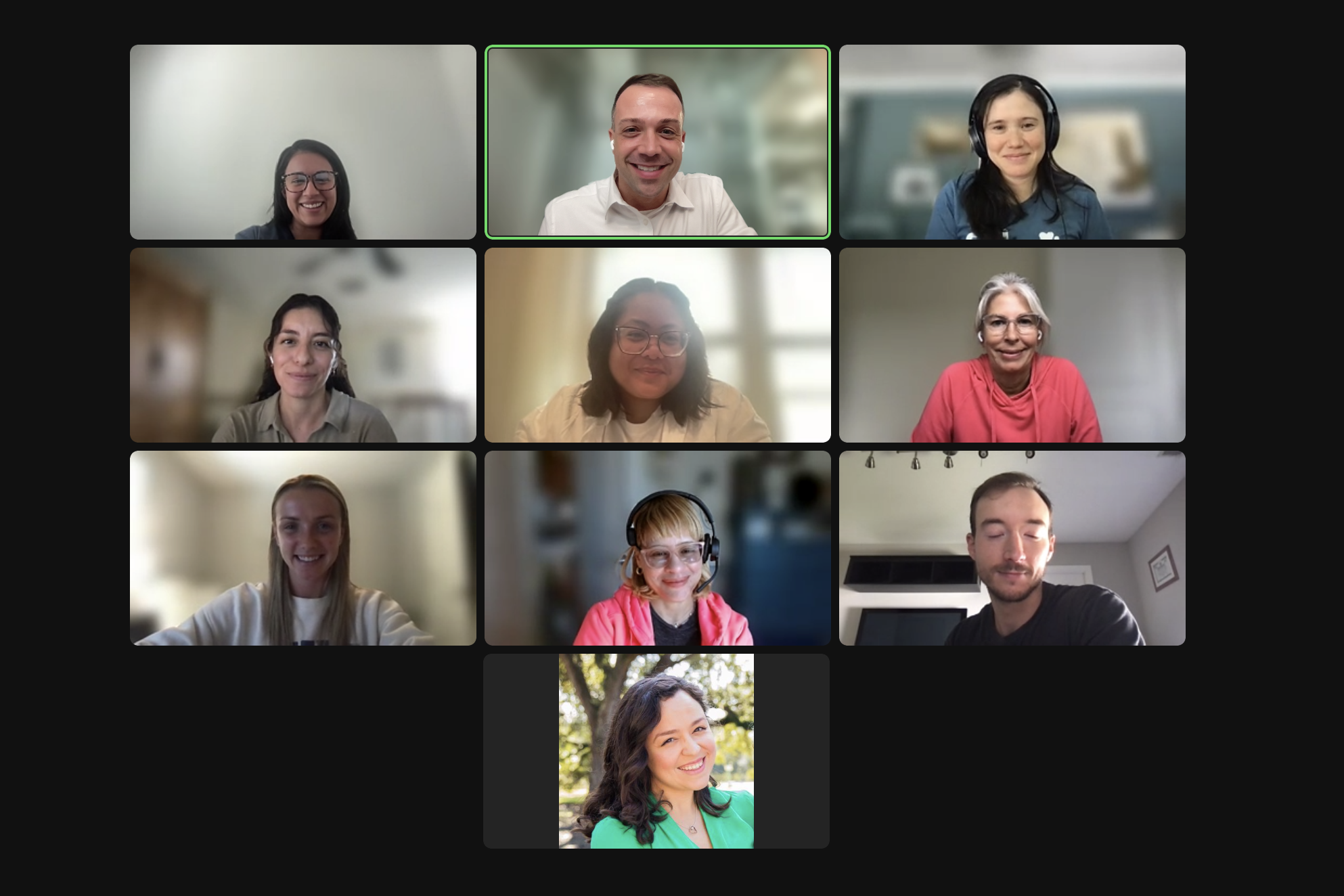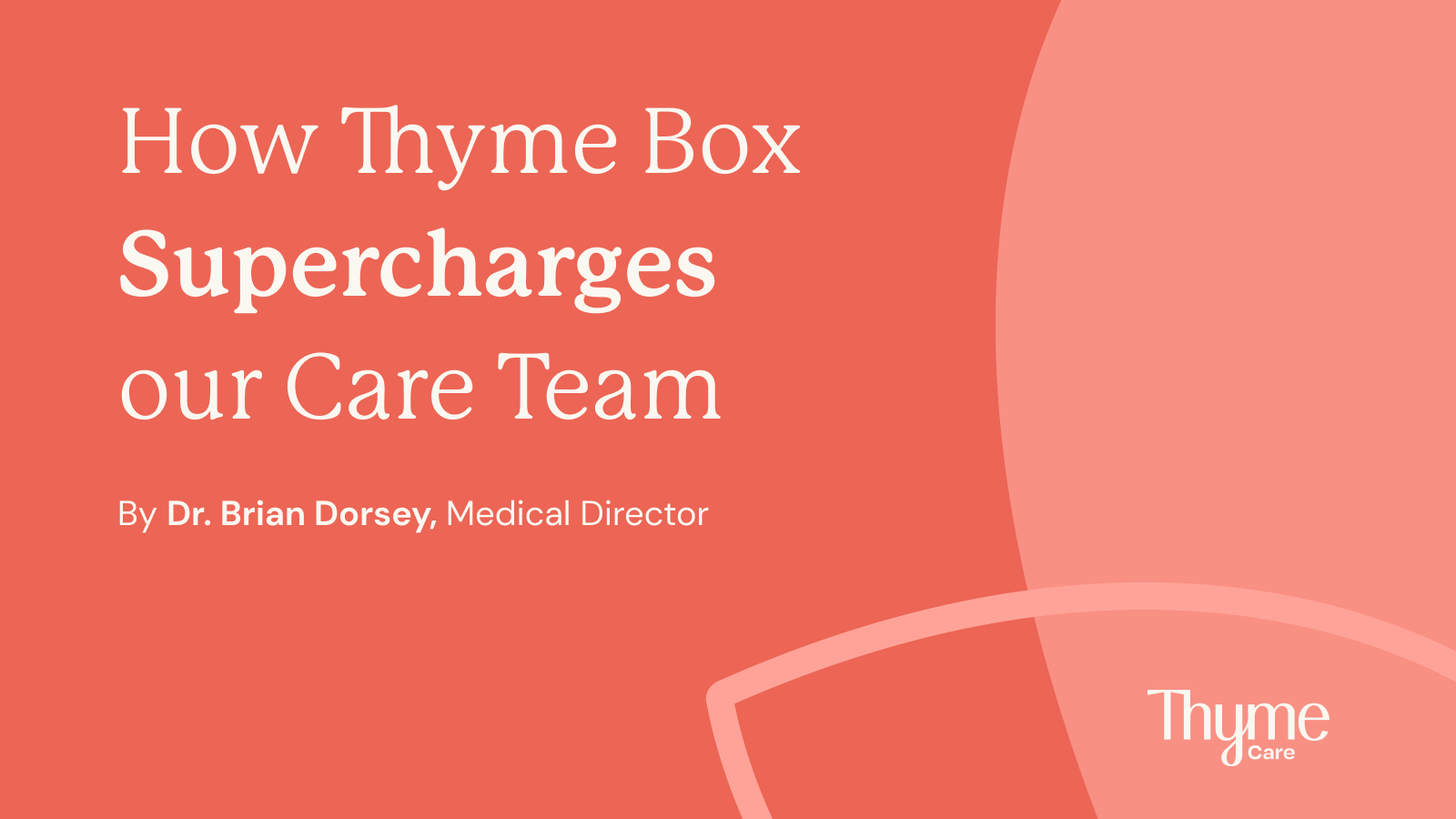How Thyme Box Supercharges our Care Team
How Thyme Box Supercharges our Care Team
At Thyme Care, we strive to deliver personalized, comprehensive cancer care support for our members. Our Care Team –a national network of nurse practitioners, oncology nurses, and resource specialists – are a key component of how we achieve this. In many ways, our Care Team is the ‘heart’ of everything we do, so today we wanted to offer a little bit of insight into who they are, and how they work in support of our members.
The Stories and Faces Behind the Pods
Care Team members live all over the country but come together virtually in “pods” to oversee the needs of members and oncology practices across specific zip codes. Each pod has at least two nurses, at least three care partners, and an administrative assistant. Nurses oversee the clinical needs of our members, while Care Partners on-board new members, check-in on their progress and symptoms, and focus on the social and personal needs that impact their health, their access to care, and their overall cancer journey.
Did you know that Care Team members get to vote on the name for their pod? The names come from a list of non-English words that have interesting inspirational or uplifting meanings. Some of the current pod names include Ohana (Hawaiian for family), Hygge (Danish for a feeling of warmth and comfort that fosters well-being), Komorebi (a Japanese word that describes Sunlight that filters between the leaves on a tree), Koselig (a Swedish word that means the art of finding light in the darkness), Meraki (A Greek work which means to do tasks with soul, creativity and love).
Cancer care is not just another job to our Care Team members. Many bring their own personal experiences with cancer, and a deep desire to do more to support members and their care providers. Many of our oncology nurses worked in hospital settings or at oncology clinics before joining Thyme Care, and experienced the challenging work of cancer care on the front lines. Some have experienced the cancer journey as a caregiver looking after a family member. Both perspectives are valuable to the work they do with members who are experiencing the challenges of chemo or radiation therapy, the difficulties of symptom management, the administrative complexity of our healthcare system, and the personal, emotional, and financial tolls of cancer care.
They understand that cancer is a complex journey during which people are often at their most vulnerable and in need of support in multiple areas of their lives.
The Ohana Pod

A Day on the Job
While every day and every problem is different for our Care Team pods, there’s a routine that brings structure and organization to their work.
Much of that routine revolves around outreach. If a new member joins, one of our care partners will reach out to introduce themselves and help with onboarding. This helps us get to know that member, find out if they have any questions or current needs for support, and let them know that the Care Team is there for them throughout their care journey.
Care partners also make calls to current members to check on their symptoms and wellbeing. Calls are organized by need, so high needs members might get a call from someone on the pod every couple weeks. About three days a week, the pods start their day with a huddle that brings nurses and care partners together to talk in real time about the members who are in need of the most attention. Twice a week, the medical director and oncology director lead case conferences, where nurses bring complex patient needs to the table for further discussion.
During outreach, care partners often learn about other non-clinical challenges that members are struggling to navigate. Some need help getting to appointments because family members aren’t available to drive them. Others are experiencing financial toxicity and can’t afford their rent, utilities, food, or medication.
When care partners learn about such situations, they go all in, seeking answers, searching for alternative resources. Recently, one care partner found out that a member was about to get utilities shut off by the end of the day. She spent hours that afternoon on the member’s behalf talking to the utility company and contacting various resources until she was finally able to secure the member a three-month extension on her bill. That care partner got a round of virtual cheers and high-fives from across the Care Team.
As another care partner shared, “Imagine going through chemo, and now you’re at risk of losing your utilities. It feels really good to know that we’re helping people in different ways.”
Another member faced extra challenges because she was also experiencing chronic disease and a number of comorbidities. The pod was able to help improve her situation. A care partner connected her with the Office of Aging in her state to get her extra social support and some financial support to pay her rent and buy food. The nurse practitioner helped her get a four-legged cane to make her more stable when she walks. And another care partner is working to get her a life alert system so she feels safe and comfortable living alone.
Sometimes, a care partner encounters a medical problem that needs to be escalated. In most cases, our care partners learn of these medical issues by proactively reaching out to members, using our Symptom ID assessment, which asks members to rate their symptoms on a scale of 0-10. When members are experiencing a tough time dealing with symptoms like pain, diarrhea, or dehydration, our care partners will contact the nurse and ask them to evaluate the member. The nurse will follow up that day to help the member, either with different things they can do at home, a referral, or by suggesting a visit to the urgent care clinic or emergency department if appropriate. Many of a nurse’s daily calls concern escalations or follow ups to see if symptoms have improved.
The Care Team also has playbooks to turn to when specific symptoms or circumstances arise. Based on evidence, guidelines, or accepted consensus, playbooks help care partners and nurses move quickly through the tasks that must be accomplished to help resolve a situation. They make helping members easier, faster, and more thorough.
Supported by Thyme Box
All of that collaboration and coordination is possible because of Thyme Box. “Thyme Box is key,” one of our care partners says. “It’s like a window into our members so we know what they need, what we've already helped them with, and what we should do next. It's a great way to start the day.”
Calls or outreach are never blind. Pod team members can see a member’s profile in Thyme Box, including a visual timeline or history of contacts and engagements with the Care Team. Whoever’s in line to make the next call has a full record of the member’s current treatment and latest developments, including their health status, ongoing concerns or needs, and even personal details, like whether they went on vacation recently or have a grandchild graduating from high school. Some care partners talk to the same members quite regularly, others are meeting the member for the first time, but Thyme Box makes that call a warm hand-off with easy rapport and engagement.
Thyme Box organizes and prioritizes tasks that need to be accomplished according to urgency. Some tasks require immediate attention, others can be done over the next few weeks. Thyme Box also now automates a lot of tasks, such as consents and note taking. During enrollment or onboarding, if a new member lets us know they need extra support related to finances, food, transportation, and so on, that automatically becomes a new task for a care partner to do a follow-up assessment on. Or. a nurse who encounters a social need can put that into the queue for a care partner. Similarly, if a care partner records a symptom assessment that hits a high number, that automatically triggers a nurse outreach. Previously, the care partner would have to escalate that manually through our Slack channel.
Thyme Box also indicates whether a member prefers texts, emails, or phone calls. If texting is preferred, it might be easiest for the care partner to text the member with a symptom assessment and follow-up by phone later. A member might also have a preferred language they like to speak in, or a family member or caregiver they want kept in the loop. It’s also easy for care partners to contact local social support organizations on behalf of members.
The Care Team members appreciate the ongoing evolution of Thyme Box. From spreadsheets to intelligent automation, Thyme Box has come a long way in a short time.
Hard Work that Really Makes a Difference
Our Care Team members are drawn to Thyme Care because they want to help people with cancer have a better care journey and experience. Thyme Box enables them to do that more efficiently and at scale. At the same time, Thyme Box also helps keep the human side of care front and center. Too many care providers and support staff in oncology are overwhelmed with the daily challenges of providing care and processing paperwork. They don’t get the opportunity to spend time with their patients and engage with them as human beings who have full lives outside of their cancer care. Thyme Box flips that problem on its head, emphasizing personal connection and taking as much of the repetitive, automated, or administrative load away as possible.
Our cancer care members and our oncology practice partners may not know about the technology behind the scenes when they get a call, text, message, or alert; but Thyme Box makes the experience of cancer care better for everyone.

